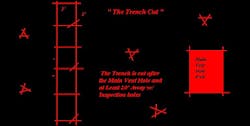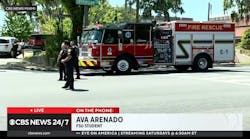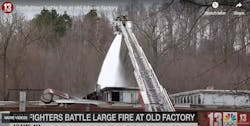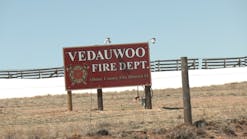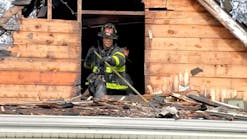A hot topic in the firehouse is roof ventilation. Although often overlooked, the position of "roof firefighter" plays an important role in the outcome of the fire and serves as both the eyes and ears of the incident commander. This is also an important position because this firefighter is usually not operating with an officer and will have to make important tactical decisions on their own.
Before heading to the roof, The roof firefighter must size up the building; look at the building and try to determine what type of construction the building is. This can be done by pre-planning, building inspections, prior fires or dispatcher information.
Is the building fireproof where we will just be ventilating a bulkhead and venting windows? Is the building of newer lightweight construction where we will not be going on the roof due to fire conditions and fear of early collapse? Or will we be using the safety of an aerial device to vent skylights and natural openings?
Is the fire on the top floor? Where will we cut the roof and will we need additional manpower for a trench operation? Or is it on a lower floor where we only need to open a stairway bulkhead or scuttle door?
The roof firefighter must also determine the safest and quickest way to the roof and have a secondary way off of the roof in an emergency. This could be done by adjoining building, aerial device or portable ladders.
Once the roof firefighter gets on the roof, he must confirm his secondary way off and get his bearings. If you stand with your back to the front wall, you are usually looking at the building the same way the incident commander is, so you know your exposures will be the same. If you become briefly disoriented you know the front wall is behind you and where your exit is. Use caution, because the front walls usually line up and the rear walls vary in depth due to the building construction. So if you have to go to the adjoining building, cross over in the front where they are aligned to avoiding falling into a shaft, which is generally located toward the rear.
The roof firefighter should also do a quick roof size up. What is the building length? And he should relay any abnormal shapes, distances, or roof loads. The roof firefighter should then perform any quick ventilation tactics, including, opening a bulkhead door and check for occupants, vent a skylight and check returns for fire in the cockloft, or open a scuttle door. He should relay any important information to the incident commander.
The roof firefighter should then do a perimeter search of the building looking for any victims or signs of fire and observe conditions on the roof. Roof conditions include, visible fire, heavy smoke, melting tar, melting snow or steaming water, roof sagging, smoldering, or a hoseline hitting the roof boards below.
Once the fire area is determined, decide where to cut. This is usually about six feet in from the front wall or over the fire area. It is better and safer to cut one hole and enlarge it then cut several smaller ones. Avoid cutting the vent hole between your primary and secondary exits off the roof.
When cutting your ventilation hole, a good technique to use is the "798" cut. This is a 3-by-3-foot hole that can be quickly pulled and extended to a 3-by-6-foot or 6-by-6-foot hole depending on fire conditions. (see diagram) If fire condition is minor, the 3-by-3-foot or 3-by-6-foot is all you will need, but for larger fires the 6-by-6 foot is preferred. If possible, the wind should be at your back and you should don full personal protective equipment and a self contained breathing apparatus.
If fire vents while cutting or pulling the hole, you can use the roofing material as a shield to protect members. You must always remember to push the ceiling down below using a hook, roofboard or even a ladder if tin ceilings are encountered. And if fire is in the cockloft prior to pushing down the ceiling, the incident commander must be notified. A good way to know if fire is in the cockloft is to examine the returns in the scuttle or skylight or make an inspection cut with the saw, which is a small triangle made from dropping the saw in the roof 3 times. These should be cut away from the vent hole to determine extension if fire gets in the cockloft.
If there is fire in the cockloft and a defensive operation is needed, we can cut a trench. This is a time and manpower consuming operation and most times fires are extinguished by members pulling ceilings below and exposing fire for the hoseline. But when we are going to go to a trench operation we are giving up the building on the opposite side of the trench and withdrawing all operating members. This tactic is usually cut in larger H-type apartment buildings or taxpayers. A trench is cut after the main ventilation hole is cut and extended and inspection holes are made to monitor extension in the cockloft. A trench is cut at least 20 feet from the main vent hole and is cut from building wall to building wall.
To start the trench cut, beging by cutting two lines, three feet apart with cross cuts and knockouts every three feet. It is important to have inspection holes on both sides of the trench to monitor fire conditions in the cockloft. The trench should be cut in a narrow part of the building like using the throat section in the H-type, or incorporating a bulkhead structure or firewall for less cutting.
The trench is cut but not pulled and the ceilings below the trench are pulled and hoselines are positioned on the roof above and on the floor below the trench. When the fire reaches the inspection holes, the trench is pulled and the hoselines are operated to hold and extinguish the fire at the trench. If fire shows at the inspection holes behind the trench, another trench cut with extension holes would be needed, and the original trench abandoned.
Due to the new building materials and methods of construction, there are many different types of roofs out there. It is extremely important that the roof firefighter knows what type of roof he is operating on. These techniques are NOT to be used on the newer, lightweight construction which tend to fail in five to 10 minutes of exposure to fire, or when a truss or chord is compromised from cutting. For these lightweight types of buildings we will vent natural openings which are usually found at the ceiling levels on the exterior walls or a skylight or scuttle.
A good way to determine the construction of a commercial building where this lightweight construction may be found, is before entering the structure, push up a ceiling tile or pull a section of ceiling and examine the cockloft from the front door. This can be done using a eight or 10 foot pike pole and checking with a handlight or thermal imaging camera to determine if there is any fire in the cockloft and the type of roof construction. The roof firefighter can also determine this by cutting an inspection hole and if any metal from Q-decking or dust from Gypsum is present or any truss is seen, the incident commander should be notified and the roof should be vacated.
Related:
- TrainingLIVE Webcast: Ventilation: The Problem & Effect On Today's Buildings
